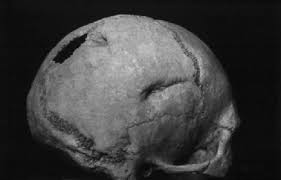This post is a collection of ‘Abstracts‘ from published studies on Trepanation in ancient China.

Abstract The term trepanation describes the removal of sections of bone from the cranium. Although others may have made earlier reference to trepanation, in 1995, Chinese archeologists discovered a skull at the Neolithic site Fujia from approximately 3000 BC (the Dawenkou Cultural Period), Guangrao, Dongying, Shandong, China, and after careful examination of the specimen, the archeologists suggested that the procedure had been performed on a living patient who subsequently survived. Archeological evidence supports that the practice of trepanation was widespread.
(Source: “Prehistoric skull trepanation in China” by Xianli Lv, Zhenguang Li, Youxiang Li)

Abstract Trepanation, the process of making a burr hole in the skull to access the brain, is an ancient form of a primitive craniotomy. There is widespread evidence of contributions made to this practice by ancient civilizations in Europe, Africa, and South America, where archaeologists have unearthed thousands of trepanned skulls dating back to the Neolithic period. Little is known about trepanation in China, and it is commonly believed that the Chinese used only traditional Chinese medicine and nonsurgical methods for treating brain injuries. However, a thorough analysis of the available archeological and literary evidence reveals that trepanation was widely practiced throughout China thousands of years ago. A significant number of trepanned Chinese skulls have been unearthed showing signs of healing and suggesting that patients survived after surgery. Trepanation was likely performed for therapeutic and spiritual reasons. Medical and historical works from Chinese literature contain descriptions of primitive neurosurgical procedures, including stories of surgeons, such as the legendary Hua Tuo, and surgical techniques used for the treatment of brain pathologies. The lack of translation of Chinese reports into the English language and the lack of publications on this topic in the English language may have contributed to the misconception that ancient China was devoid of trepanation. This article summarizes the available evidence attesting to the performance of successful primitive cranial surgery in ancient China.
(Source: “Trepanation in Ancient China”, by Leah Hobert, Emanuela Binello)

Abstract This study uses multiple scientific methods to analyse a case of trepanation from a cemetery located at the westernmost point along the ancient Silk Road in China dating back to the Early Iron Age. The skull of interest belonged to a middle-aged male; the opening is located on the left posterior side of the skull in the occipital bone. Computer tomography (CT) and microscopic observation show that the incision was unhealed, indicating an immediate death either during or after the operation. The procedure of trepanation might have been used to treat a depressed fracture from inflicted trauma on the individual’s right parietal bone, suggesting the presence of surgical trepanation in early Western China.
(Source: “A scientific analysis of cranial trepanation from an Early Iron Age cemetery on the ancient Silk Road in Xinjiang, China”, by Qun Zhang et al.)

Abstract This paper presents an archaeological case study of a trepanation specimen from Minhe, Qinghai Province which can be dated back to 3770±30BP. The trepanation individual was discovered at Yangshan cemetery, the funerary objects indicate the burials belong to the Banshan Type under the Majiayao Culture, a famous prehistory archaeological culture in Western China. This study presented here combines CT scanning and 3D deep field microscopic analysis to observe the intentional trepanation. The macroscopic hole observed on frontal bone is located in front of the bregma precisely. The skull was scanned with a 64-slice CT and the hole was observed directly with a 3D deep field microscope, on the edge of the hole, a new bone formation with an uneven surface and thin bony outgrowth can be observed, demonstrating the high possibility of the earliest healed intentional trepanation in western China known to date. As to the intention and technique applied on this case, considering the location, size and shape, the trepanation was probably performed out of medical treatment after compared with the other cases in the world and the stone chisel unearthed from the cemetery may be the tools used in the trepanation.
(Source: “A case of neolithic cranial trepanation in Qinghai, China”, by Qun Zhang et al.)

Summary Trepanation is defined as the intentional removal of a piece of bone from the cranial vault of a living individual without penetration of the underlying soft tissues. In China, practicing trepanation can be traced back to the Neolithic, and it can still be found today in some populations in other parts of the world. Nine skulls with lesions from four Late Bronze Age and Early Iron Age cemeteries (Yaer from Hami, Goukou from Jinghe, Yanghai from Tulufan, and Choumeigou from Changji) (4000BP–2000 BP) in Xinjiang were investigated macro- and microscopically. In conjunction with other information obtained through generation of bioarchaeological profiles of these skeletal assemblages, the aim of this study is to contextualize the observed trepanation cases with their archaeological settings and to explore their temporal and spatial distribution and social/cultural implications. Signs of new bone deposition, implying the short or long-term survival of all individuals after the operation, may indicate that during the Late Bronze and Early Iron Ages in Xinjiang trepanation had been a well-practiced procedure, in turn supporting the suggestion of its importance as a therapeutic method in these ancient peoples.
(Source: “Cranial Trepanations in Bronze Age and Early Iron Age Xinjiang”, by Dong Wei, Si Yang)

Research-Selection for NovoScriptorium: Maximus E. Niles

Leave a comment